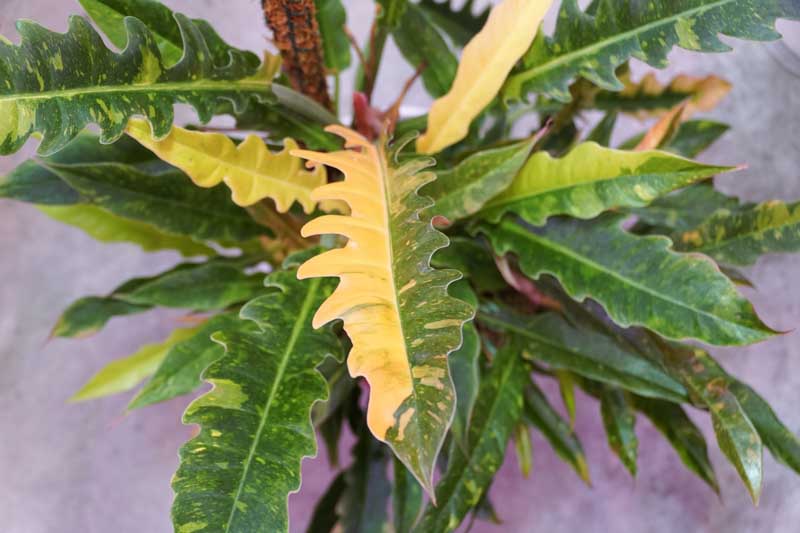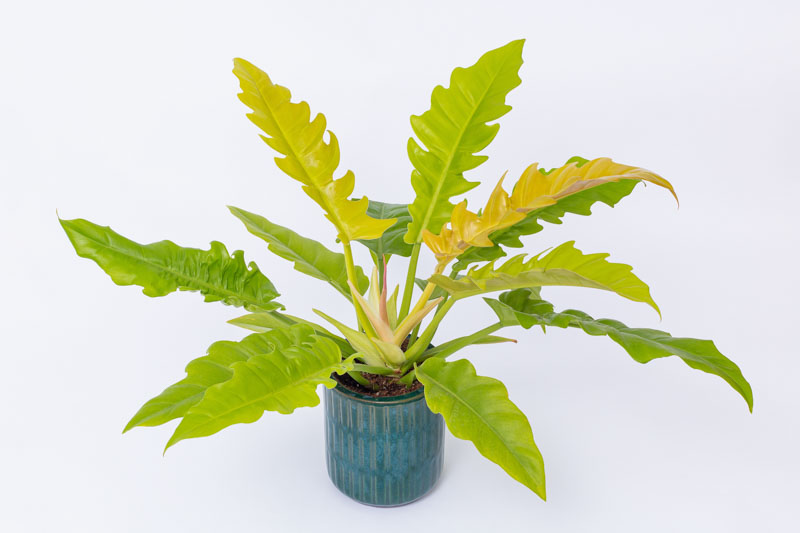Ring of Fire Philodendron, Philodendron bipinnatifidum x selloum
Philodendron ‘Ring of Fire’ is an exceptional cultivar within the Philodendron family, celebrated for its striking variegated foliage that showcases a fiery array of colors. This rare and sought-after plant is a testament to the beauty and diversity that can be found in cultivated houseplants.
Philodendron ‘Ring of Fire’ features an impressive display of multicolored leaves, with variegation that includes shades of green, yellow, orange, and even deep red, reminiscent of a flame. The leaves are elongated and deeply lobed, adding to the plant’s dramatic appearance. Each leaf is unique, making ‘Ring of Fire’ a captivating addition to any plant collection.
Native: As a cultivated variety, Philodendron ‘Ring of Fire’ does not have a specific native habitat. However, the Philodendron genus itself originates from the tropical regions of the Americas, where these plants thrive in warm, humid environments. It belongs to the arum family (Araceae), along with Zantedeschia (Calla Lily), Caladium (Angel Wing), Monstera (Swiss Cheese Plant), or Colocasia (Elephant Ear).
Plant Type and Habit: Philodendron ‘Ring of Fire’ is a hybrid that exhibits a climbing or vining habit, making it adaptable to various display methods. This evergreen vine can be trained to climb up a support structure or allowed to trail from a hanging basket, providing flexibility in how it’s incorporated into indoor spaces.
Size: When given the proper support, ‘Ring of Fire’ can reach 8 feet in height (240 cm) and 6 feet in width (180 cm). The plant’s size and the extent of its spread can be managed through pruning and the choice of support, allowing it to be tailored to the available space.
Flowers: While Philodendron ‘Ring of Fire’ can produce flowers, it is primarily grown for its spectacular foliage. The flowers, typical of the genus, feature a spadix surrounded by a spathe but are infrequently seen in household environments.
Foliage: The foliage of Philodendron ‘Ring of Fire’ is its standout feature, with each leaf presenting a mesmerizing blend of colors. The variegation patterns are highly variable, ranging from subtle streaks to bold splashes of color, contributing to the plant’s allure and desirability among collectors.
Hardiness: It is hardy in USDA zones 10 to 11 and prefers temperatures between 65°F (18°C) and 85°F (29°C). It requires protection from cold drafts and temperatures below 60°F (15°C).
Uses: Its striking appearance makes it a focal point in any room, enhancing living spaces, offices, and commercial settings with its vibrant foliage. Additionally, its climbing habit offers creative possibilities for vertical gardening, making it a versatile choice for interior decorating.
Toxicity: Philodendrons are toxic to humans, cats, and dogs if ingested. They contain calcium oxalate crystals that can cause mouth and stomach irritation. Contact with the sap may cause skin irritation.
Benefits: Beyond its ornamental value, Philodendron ‘Ring of Fire’ is valued for its air-purifying properties, capable of filtering out certain toxins and improving indoor air quality.

Light: Prefers bright, indirect light to maintain its unique variegation. Direct sunlight can scorch the leaves, while too little light may reduce the vibrancy of its colors. An east or west-facing window covered with a sheer curtain is ideal.
Soil: Thrives in well-draining, rich, organic soil. A mix of peat moss, perlite, and vermiculite or orchid bark provides the perfect balance for moisture retention and adequate drainage.
Water: Water when the top inch of soil becomes dry to the touch. Philodendron ‘Ring of Fire’ likes consistent moisture but is susceptible to root rot in overly wet conditions. Ensure the pot has good drainage to prevent waterlogging.
Temperature and Humidity: Prefers warm temperatures between 65°F (18°C) and 85°F (29°C). Protect it from cold drafts and sudden temperature drops to avoid stress. Prefers higher humidity levels, around 60-80%. Use a humidifier, mist the plant regularly, or place it on a pebble tray with water to increase ambient humidity, mimicking its tropical habitat.
Fertilization: Fertilize every 4-6 weeks during the growing season (spring to summer) with a balanced, liquid fertilizer diluted to half the recommended strength. Reduce fertilization in fall and winter when growth naturally slows.
Support: Being a climber, ‘Ring of Fire’ benefits from a moss pole, trellis, or other support to encourage vertical growth. This support can also help enhance leaf size and variegation.
Pruning: Prune any yellow or damaged leaves to encourage healthy growth. Light pruning can also help maintain the plant’s shape and promote fuller growth.
Repotting: Repot every 2-3 years, or when the plant becomes root-bound, in spring. Choose a pot only slightly larger than the current one to prevent excess soil moisture.
Propagating Philodendron plants is a straightforward and rewarding process, allowing you to expand your collection or share with friends and family. The most common method is stem cuttings, which can be rooted in water or soil. Here’s how to do it:

Philodendrons can encounter pests, diseases, and other common problems, especially when grown indoors.
Spider Mites: These tiny pests can be identified by the fine webs they weave on the plant. They cause yellowing or speckled leaves. Increase humidity around the plant and wash it with a strong stream of water. For severe infestations, use insecticidal soap or neem oil.
Mealybugs: These white, cottony pests tend to cluster in leaf axils and under leaves, sucking sap and weakening the plant. Remove with alcohol-dipped cotton swabs or apply neem oil.
Aphids: Small, soft-bodied insects that can be green, black, brown, or pink, aphids typically feed in groups on the undersides of leaves. Combat them with a gentle spray of water, neem oil, or insecticidal soap to protect the plant’s health and appearance.
Scale insects: Hard or soft-bodied insects that attach themselves to the stems or leaves, causing yellowing and growth stunting. Scrape off with a fingernail or use a cotton swab dipped in rubbing alcohol. Insecticidal soap or neem oil may also be used.
Root rot: Overwatering is the primary cause, leading to brown, mushy roots and yellowing leaves. Reduce watering, improve drainage, and repot the plant into fresh, well-draining soil. Severely affected roots should be trimmed before repotting.
Leaf spot: Fungal or bacterial infections can cause dark or black spots on leaves, often with a yellow halo. Increase air circulation, avoid wetting leaves when watering, and remove affected leaves. Fungicides or bactericides may be necessary in severe cases.
Yellowing Leaves: Often a sign of overwatering or poor drainage. Ensure the plant is in well-draining soil and adjust your watering schedule to allow the soil to dry slightly between waterings.
Brown Leaf Tips: Can indicate low humidity, especially in dry indoor environments. Increase humidity around the plant with a humidifier, pebble tray, or by misting the leaves regularly.
Leaf Scorch: Direct sunlight can cause the leaves to scorch, leading to brown patches or fading of the vibrant leaf colors. Position the plant in a location where it receives bright, indirect light.
Drooping Leaves: This can be a sign of both underwatering and overwatering. Check the soil moisture to determine the cause and adjust your watering accordingly.
Slow Growth or Lack of Color: Insufficient light can lead to less vibrant leaf coloration and slow growth. Ensure your philodendron is receiving enough indirect light to maintain its rich hues and promote healthy growth.
| Hardiness |
10 - 11 |
|---|---|
| Plant Type | Houseplants, Climbers |
| Plant Family | Araceae |
| Genus | Philodendron |
| Exposure | Partial Sun |
| Season of Interest |
Spring (Early, Mid, Late) Summer (Early, Mid, Late) Fall Winter |
| Height |
7' - 8' (210cm - 240cm) |
| Spread |
5' - 6' (150cm - 180cm) |
| Maintenance | Low |
| Water Needs | Average |
| Soil Type | Loam |
| Soil pH | Acid, Neutral, Alkaline |
| Soil Drainage | Moist but Well-Drained |
| Characteristics | Showy, Evergreen |
| Tolerance | Deer, Rabbit |
| Garden Uses | Hanging Baskets, Patio And Containers |
| Hardiness |
10 - 11 |
|---|---|
| Plant Type | Houseplants, Climbers |
| Plant Family | Araceae |
| Genus | Philodendron |
| Exposure | Partial Sun |
| Season of Interest |
Spring (Early, Mid, Late) Summer (Early, Mid, Late) Fall Winter |
| Height |
7' - 8' (210cm - 240cm) |
| Spread |
5' - 6' (150cm - 180cm) |
| Maintenance | Low |
| Water Needs | Average |
| Soil Type | Loam |
| Soil pH | Acid, Neutral, Alkaline |
| Soil Drainage | Moist but Well-Drained |
| Characteristics | Showy, Evergreen |
| Tolerance | Deer, Rabbit |
| Garden Uses | Hanging Baskets, Patio And Containers |
How many Philodendron ‘Ring of Fire’ do I need for my garden?
| Plant | Quantity | |
|---|---|---|
| Philodendron ‘Ring of Fire’ | N/A | Buy Plants |
Create a membership account to save your garden designs and to view them on any device.
Becoming a contributing member of Gardenia is easy and can be done in just a few minutes. If you provide us with your name, email address and the payment of a modest $25 annual membership fee, you will become a full member, enabling you to design and save up to 25 of your garden design ideas.
Join now and start creating your dream garden!
Create a membership account to save your garden designs and to view them on any device.
Becoming a contributing member of Gardenia is easy and can be done in just a few minutes. If you provide us with your name, email address and the payment of a modest $25 annual membership fee, you will become a full member, enabling you to design and save up to 25 of your garden design ideas.
Join now and start creating your dream garden!